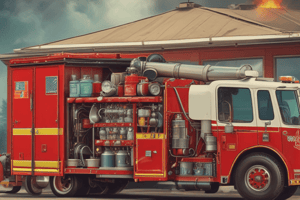Podcast
Questions and Answers
In which situation should a fire apparatus come to a complete stop before proceeding?
In which situation should a fire apparatus come to a complete stop before proceeding?
- At a clear intersection
- At a stop signal (correct)
- At an intersection with green light
- At a yield sign
When can fire units exceed posted speed limits during emergency response?
When can fire units exceed posted speed limits during emergency response?
- Only in heavy traffic and poor weather conditions
- Regardless of traffic and weather conditions
- Only on highways
- Only in light traffic and good weather conditions (correct)
Why should the fire apparatus be driven in the far left lane on streets with multiple lanes?
Why should the fire apparatus be driven in the far left lane on streets with multiple lanes?
- To maintain a consistent speed with other vehicles
- To avoid intersections
- To avoid pedestrian crossings
- To provide ample room for other drivers to pull to the right and stop (correct)
What code does the fire apparatus proceed with lights and sirens?
What code does the fire apparatus proceed with lights and sirens?
What is the recommended following distance during poor driving conditions?
What is the recommended following distance during poor driving conditions?
Which distance includes the time to recognize a hazard and apply brakes?
Which distance includes the time to recognize a hazard and apply brakes?
What does total stopping distance refer to?
What does total stopping distance refer to?
What is braking distance?
What is braking distance?
What factors affect the stopping ability of an apparatus?
What factors affect the stopping ability of an apparatus?
What is liquid surge?
What is liquid surge?
What should be done if in a skid?
What should be done if in a skid?
What should be done when traveling down a steep grade to avoid brake fade?
What should be done when traveling down a steep grade to avoid brake fade?
What action should be taken when approaching a blocked intersection with a fire apparatus?
What action should be taken when approaching a blocked intersection with a fire apparatus?
What is the purpose of staging in firefighting operations?
What is the purpose of staging in firefighting operations?
When is Level II staging utilized in firefighting operations?
When is Level II staging utilized in firefighting operations?
How should apparatus positioning be determined at a fire scene?
How should apparatus positioning be determined at a fire scene?
What should be ensured when civilians are potentially trapped in a structure fire?
What should be ensured when civilians are potentially trapped in a structure fire?
What is the recommended minimum distance aerial apparatus should maintain from all overhead wires?
What is the recommended minimum distance aerial apparatus should maintain from all overhead wires?
What is the designed collapse zone in relation to the height of a building?
What is the designed collapse zone in relation to the height of a building?
What should be the position of the apparatus when laying hose from the hose bed in relation to the hydrant?
What should be the position of the apparatus when laying hose from the hose bed in relation to the hydrant?
Wheel chocks are designed to do what?
Wheel chocks are designed to do what?
What is the maximum wind range that aerial apparatus are designed to be operated in?
What is the maximum wind range that aerial apparatus are designed to be operated in?
What does an auxiliary appliance refer to?
What does an auxiliary appliance refer to?
What is the purpose of the advanced warning area in traffic incident management?
What is the purpose of the advanced warning area in traffic incident management?
In traffic incident management, what defines the traffic space?
In traffic incident management, what defines the traffic space?
What characterizes a minor traffic incident according to MUTCD classifications?
What characterizes a minor traffic incident according to MUTCD classifications?
Why is it safer to divert traffic with advanced placement of signs and cones than to rely on apparatus lights?
Why is it safer to divert traffic with advanced placement of signs and cones than to rely on apparatus lights?
What is the minimum duration for a traffic incident to be classified as a major traffic incident according to MUTCD?
What is the minimum duration for a traffic incident to be classified as a major traffic incident according to MUTCD?
Which area of traffic incident management involves work activity taking place?
Which area of traffic incident management involves work activity taking place?
What does the buffer space in traffic incident management refer to?
What does the buffer space in traffic incident management refer to?
What unit should be utilized as the first blocker?
What unit should be utilized as the first blocker?
What is the recommended distance for nonessential incoming apparatus to stage from a trench collapse?
What is the recommended distance for nonessential incoming apparatus to stage from a trench collapse?
Where should fire apparatus park during EMS calls?
Where should fire apparatus park during EMS calls?
Flashcards are hidden until you start studying




